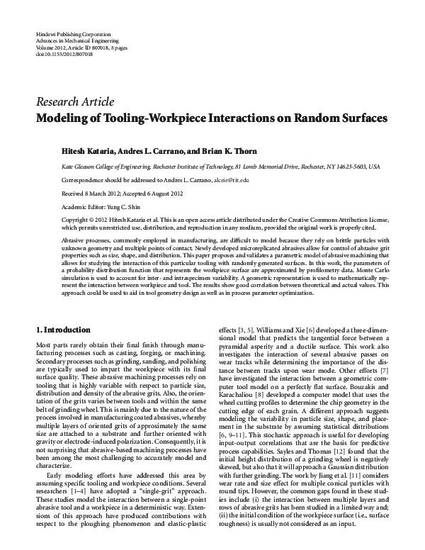
Article
Modeling of Tooling-Workpiece Interactions on Random Surfaces
Advances in Mechanical Engineering
(2012)
Abstract
Abrasive processes, commonly employed in manufacturing, are difficult to model because they rely on brittle particles with unknown geometry and multiple points of contact. Newly developed microreplicated abrasives allow for control of abrasive grit properties such as size, shape, and distribution. This paper proposes and validates a parametric model of abrasive machining that allows for studying the interaction of this particular tooling with randomly generated surfaces. In this work, the parameters of a probability distribution function that represents the workpiece surface are approximated by profilometry data. Monte Carlo simulation is used to account for inter- and intraspecimen variability. A geometric representation is used to mathematically represent the interaction between workpiece and tool. The results show good correlation between theoretical and actual values. This approach could be used to aid in tool geometry design as well as in process parameter optimization.
Keywords
- Modeling,
- Tooling-workpiece interactions,
- Random surfaces,
- Mechanical engineering
Disciplines
Publication Date
January 1, 2012
DOI
10.1155/2012/807018
Publisher Statement
Copyright © 2012 Hitesh Kataria et al. This article is distributed under the terms of the Creative Commons Attribution 3.0 License (http://www.creativecommons.org/licenses/by/3.0/) which permits any use, reproduction and distribution of the work without further permission provided the original work is attributed as specified on the SAGE and Open Access page (http://www.uk.sagepub.com/aboutus/openaccess.htm).
Citation Information
Hitesh Kataria, Andres L. Carrano and Brian K. Thorn. "Modeling of Tooling-Workpiece Interactions on Random Surfaces" Advances in Mechanical Engineering Vol. 4 (2012) p. 1 - 8 ISSN: 1687-8132 Available at: http://works.bepress.com/andres-carrano/10/
